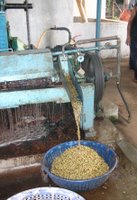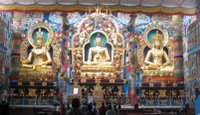Coffee, Pepper, Vanilla and Elephants
 We met Rich and Marion Arnold through the Overseas Women’s Club and hit it off immediately. After several delightful lunches and dinners, we decided to take a long weekend together to Orange County Resort in the Dubare Forest near Coorg, about 200 km. southwest of Bangalore. Rich was able to secure a six passenger van with a driver who knew the way so we were comfortable for the seven hour drive there and seven hour drive back.
We met Rich and Marion Arnold through the Overseas Women’s Club and hit it off immediately. After several delightful lunches and dinners, we decided to take a long weekend together to Orange County Resort in the Dubare Forest near Coorg, about 200 km. southwest of Bangalore. Rich was able to secure a six passenger van with a driver who knew the way so we were comfortable for the seven hour drive there and seven hour drive back.
We were pleasantly surprised by our accommodations. We slept in a tent, but this tent had a floor, indoor plumbing, and a/c! It was about 20 ' long, 14' wide and the peak was about 12' high.
 The resort is situated in the middle of a 300 acre coffee plantation, and after checking in at 2:00, we discovered we were comfortably in time for a two hour walking tour through the plantation with a guide to show us a variety of plants and birds. This plantation grows two kinds of coffee for export; Robusta, which is a mild coffee, and Arabica, which is stronger. The trees are pruned regularly and the trunks are quite knurled. A surprising discovery is that the coffee plant can have blossoms and ripe berries on it at the same time.
The resort is situated in the middle of a 300 acre coffee plantation, and after checking in at 2:00, we discovered we were comfortably in time for a two hour walking tour through the plantation with a guide to show us a variety of plants and birds. This plantation grows two kinds of coffee for export; Robusta, which is a mild coffee, and Arabica, which is stronger. The trees are pruned regularly and the trunks are quite knurled. A surprising discovery is that the coffee plant can have blossoms and ripe berries on it at the same time. 
 Yes, coffee beans are picked by hand. They are then brought to a machine where they are washed and the skins rubbed off. The beans inside are a vanilla color and are referred to as parchment beans. The beans are spread out on a cement slab to dry. In this state, the coffee beans will last for as long as 20 years. After drying they are bagged and shipped to a roasting plant.
Yes, coffee beans are picked by hand. They are then brought to a machine where they are washed and the skins rubbed off. The beans inside are a vanilla color and are referred to as parchment beans. The beans are spread out on a cement slab to dry. In this state, the coffee beans will last for as long as 20 years. After drying they are bagged and shipped to a roasting plant.Among the coffee trees were many taller trees that served a dual purpose; they provided a shady canopy for the coffee and a medium for other crops to grow on. Every one of the shade trees also had a pepper vine or a vanilla vine growing up it.
Black pepper and white pepper come from the same plant. The difference is that for white pepper, the peppercorn is picked when it’s green and the skin is rubbed off. The seed inside is white. Black pepper is allowed to stay on the vine until it fully ripens, dehydrates and turns black. Pepper grows in clusters at the end of a stem, and there may be as many as 30 peppercorns on one stem. There are hundreds of clusters on a plant.

Vanilla grows on a thick vine with thick leaves about ¾” wide and 4-5inches long spread far apart. Where the blossom appears, a stem-like structure grows out of that, and 5-6 beans will grow along that stem. Boy, did we learn a lot!

On Saturday we visited an elephant camp. The tourists are allowed to get into the river and help bathe the elephants, then go to the feeding area and feed
 them. What an experience! We also learned six differences between African and Asian elephants that relate to their ears, nose, toes, height, weight, and gestation periods.
them. What an experience! We also learned six differences between African and Asian elephants that relate to their ears, nose, toes, height, weight, and gestation periods.From there we visited the Tibetian Settlement at Bylakuppe. There are huge Buddhist monasteries and temples here that leave you wondering if you have crossed the border into Tibet. Inside are huge statues covered in gold and
 intricate paintings that were just as impressive
intricate paintings that were just as impressive  and awe-inspiring as the Catholic churches we visited in Italy. It brought to mind a headline we read in our local paper last week, “God is too big for one religion.”
and awe-inspiring as the Catholic churches we visited in Italy. It brought to mind a headline we read in our local paper last week, “God is too big for one religion.”

2 Comments:
Wow! Sounds like a fantastic trip! I'm sure the elephant smelled better after the bathing experience but did you?
Your blog is so imformative-I learn something new from it each day.
God is too big for one religion.
Oh, absolutely! And thank you so much for doing this - it's a treat.
And yes, Jay - if you think the name looks familiar...well. I am still the Ultimate Arbiter of Grace and Style, at least for those who allow me to be.
Post a Comment
<< Home